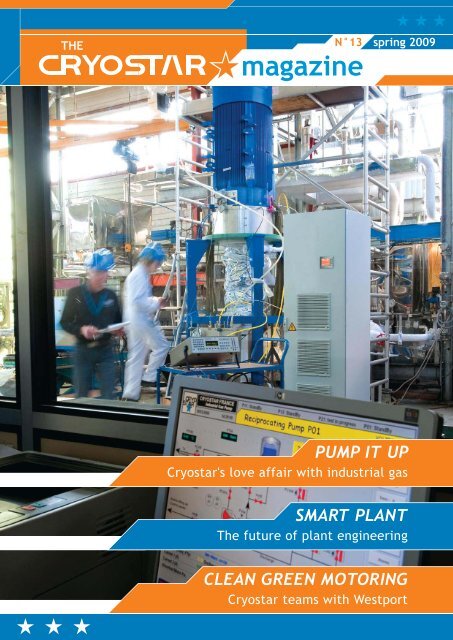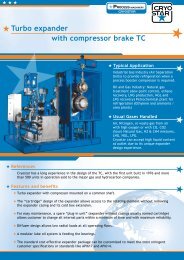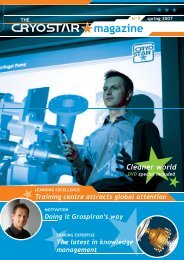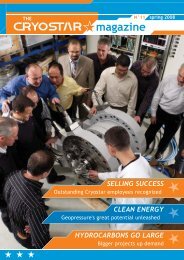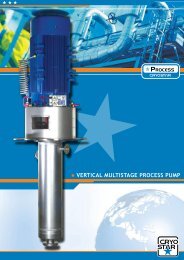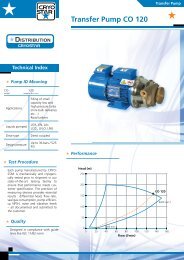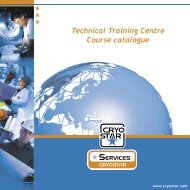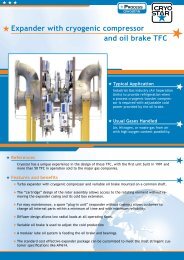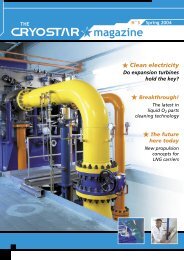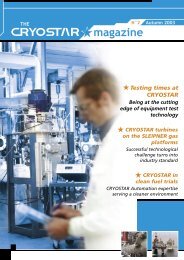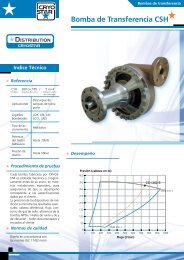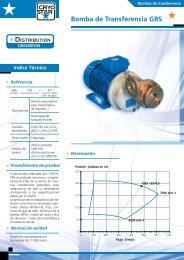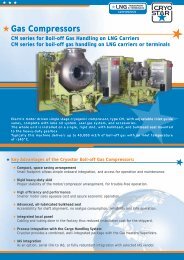CLEAN GREEN MOTORING SMART PLANT PUMP IT UP - Cryostar
CLEAN GREEN MOTORING SMART PLANT PUMP IT UP - Cryostar
CLEAN GREEN MOTORING SMART PLANT PUMP IT UP - Cryostar
- No tags were found...
You also want an ePaper? Increase the reach of your titles
YUMPU automatically turns print PDFs into web optimized ePapers that Google loves.
N°13spring 2009<strong>PUMP</strong> <strong>IT</strong> <strong>UP</strong><strong>Cryostar</strong>'s love affair with industrial gas<strong>SMART</strong> <strong>PLANT</strong>The future of plant engineering<strong>CLEAN</strong> <strong>GREEN</strong> <strong>MOTORING</strong><strong>Cryostar</strong> teams with Westport
SUMMARY36891011Pump it upLNG MotoringSmart PlantCommissioning StoryBusiness CentresNewsTraining CentreED<strong>IT</strong>ORIALHeart and soulToday <strong>Cryostar</strong> competes strongly in all of its businesssegments, but the company’s foundations are built on industrialgas. This segment is where <strong>Cryostar</strong> started out,and remained the sole focus for many years. Although todayindustrial gas is joined by its fellow business segments in<strong>Cryostar</strong>, it remains the heart and soul of the business.We hope you enjoy the lead article on p3 of this Spring’s<strong>Cryostar</strong> Magazine, intended as a pull out guide to pumpsfor industrial gas applications.<strong>Cryostar</strong>’s activities in the industrial gas business beganin 1966 as a joint venture between the US industrial gascompany, Airco Inc, and Swiss compressor manufacturer,Burckardt. Until 1983, <strong>Cryostar</strong> was the European arm ofthe Airco Cryogenics Division. Then the company began toevolve from pure pump manufacturer to progressively takingon the manufacturing of compressors and turbines. Firstbased in Switzerland, <strong>Cryostar</strong> started a production facilityin Hesingue, France, in 1973. The site is a few kilometresfrom the Swiss boarder, and remains the company’s headquartersand main production site today.<strong>Cryostar</strong>’s strategy in the industrial gas segment is relativelysimple, and is based on two pillars: First, build onthe technological know-how and experience the companyhas accumulated over more than four decades. With around100 engineers, <strong>Cryostar</strong> has a higher development potentialthan most of its competitors. <strong>Cryostar</strong> is resolutely thetechnological leader in its field and significantly invests inR&D, not only in response to specific issues but also inanticipation of tomorrow’s needs.The second pillar centres on <strong>Cryostar</strong>’s service organisation.The company has progressively opened service centresacross the world starting in the UK in 1985, followed bySingapore, then the US East and West coasts, China andlately Brazil. There are more to come in the near futurebecause the company considers that being close to its customersis key to success in this business.From an historical as well as from a technical point of view,industrial gas is <strong>Cryostar</strong>’s core segment. We view this business,although now mature, as a growth driver with increasingapplications such as Gas-to-Liquid or Coal-to-Liquidthat are demanding more and larger equipment. Despitethe present economic crisis, which may slow activity for atime, certain geographical areas will continue to invest andconsequently need air gases.<strong>Cryostar</strong> supplies pumps and turbines to all major industrialgas companies worldwide. The figures speak for themselves:In 2007 and 2008, <strong>Cryostar</strong> received more than €70 millionin new equipment bookings annually.Daniel MEYERPresident2Spring 2009
<strong>PUMP</strong> <strong>IT</strong> <strong>UP</strong>Pump it upHistorically and technically, industrial gas has been the mainstay of <strong>Cryostar</strong>’sbusiness. Industrial gas continues as a major growth driver today for the company,which supplies over €70 million in orders for pumps and turbines to the world’smajor industrial gas companies each year.Distribution pumpsLiquefied gas transfer from a trailer to a stationarytank is done either by gravity or by transferpumps. Until around 20 years ago, the transferwas only effected by gravity: the pressure in thetrailer tank was very high, the tank was heavyand the transfer was slow. However, there wasa growing need to transport more liquefied gas.New, low-pressure trailers hit the market, whichwere able to transport more liquid and featureda transfer pump. This pump significantly cuttransfer time, and could be mounted on thetrailer or the ground.Always at the forefront of cryogenic technology,<strong>Cryostar</strong> reacted rapidly in the 1980s by designinga unique transfer pump specifically designedfor this type of application: the GBS. In 1985,this was the first pump to introduce the compositemechanical seal, with four times the lifetimeof a carbon seal.Thanks to its reputation for reliability androbust design, the GBS became the market goldstandard. Today <strong>Cryostar</strong> remains the leader inthis market due to its constant effort to improvetechnology and design.Recently, requirements demanding high pressureliquid delivery, amongst others for Laser applications,appeared on the market. <strong>Cryostar</strong> imme-diately contacted customers to analyse their newflow and pressure requirements. The company’sResearch and Development department thencreated a new GBS model: the GBSD, which isavailable in two versions: GBSD 155/4.5 andGBSD 185/3.The GBSD retains all the features that makethe GBS a runaway success of. To meet customers’needs, <strong>Cryostar</strong> developed breakthroughtechnology in the GBSD. This system does notoperate through a gearbox but is driven by avariable frequency drive with power capacity upto 37kW. As a consequence the enhanced performancepump is also much simpler to maintain,cutting out the need for gearbox oil. The GBDStakes the GBS’s most successful ingredients andadds heightened performance and a motor customdesigned in cooperation with a major motormanufacturer.Since 1980, <strong>Cryostar</strong> has sold more than 3800GBS pumps. The newer GBSD has sold 200 sinceits launch. This success is also thanks to customers:<strong>Cryostar</strong>’s constant efforts to make itsproducts the best are driven by their inputs andchanging needs. This GBSD certainly won’t bethe last product development: <strong>Cryostar</strong> is alwaysimproving its solutions to increase customerproductivity.Spring 20093
<strong>PUMP</strong> <strong>IT</strong> <strong>UP</strong>Another market subject to a rapid shift in recentyears is Cylinders Filling Stations. Indeed the marketis constantly asking for more precise systems withhigh safety and reliability levels, especially formedical applications. <strong>Cryostar</strong> Automation, based inCapdenac, France is deeply involved in this move byadapting its product range to fit customer requests.The latest improvements include medical validationand filling by Coriolis Massflow Meter. Updates tothe Supervision System allow complete real timevisualisation of the filling plant with production andmaintenance records from one PC.<strong>Cryostar</strong> today offers filling systems that coverthe simplest manual unit to the most sophisticatedautomatic units, to meet all types of customers’demands.Process pumpsThe process pump story all really started at the endof the eighties. The big industrial gas companies andtheir engineering departments developed new airseparation unit plants (ASUs), with bigger capacitiesand greater efficiencies. The big gas companiescontacted <strong>Cryostar</strong> to ask it to developpumps for these new units.Until then, the centrifugal pumps used in these plantshad performances limited to the needs of that time:approximately 800 l/mn with discharge pressures of40 bars maximum.New ASU processes demanded higher dischargepressures and the famous <strong>Cryostar</strong> 2-stage horizontalpump (CD2/295) could no longer satisfy thesehigh discharge pressure needs.It was time to re-think the whole technical approachand design for this product. The philosophyof a horizontal pump with a mechanical seal as itssealing device and a gearbox allowing higher speedand pressure, was no longer adapted to the client’srequirement and specifications.The need for higher discharge pressure led <strong>Cryostar</strong>to develop vertical multi stage pumps.Customer specifications also requested that pumpsshould be able to work at least 8000 hours continuallybetween maintenances and to be permanentlymaintained cold to assure instant start up as well ashave a net positive section head required (NPSHR)as low as possible, and also entirely comply withIGC code (Industrial Gas Comity 11/82).The industrial gases industry also started to consideroperation and maintenance costs (OPEX operationalexpenditure). <strong>Cryostar</strong> needed to include these elementsin its pump design. From all these compliedelements resulted the design of the famous VP (verticalpump) multi stage pump.4Spring 2009
<strong>PUMP</strong> <strong>IT</strong> <strong>UP</strong>This pump includes all security and technical elementsthat make it an industrial gas market bestseller.It can reach discharge pressures of 130 bars and flowrates above 3000 l/min. There are six different typeswith up to 12 stages. This VP pump was developed toobtain an extremely reliable product allowing largemaintenance intervals (every two years minimum).It includes a gas or labyrinth seal, all features forautomatic functioning, to stay permanently cold andto protect the motor bearings.The pump’s materials are compatible with oxygenoperation. The isolation, a thermal barrier design,not only protects the pump from cold migrationbut also guards the client’s installation from frost.The motor/pump shaft coupling allows dismantlingfrom the top but also intervention on the labyrinthor replacement by a new gas seal, without any modificationor need to entirely dismantle the pump. Takingjust a few hours, this feature has helped manycompanies that have chosen to replace labyrinthseals with gas seals, which are less expensive in sealgas consumption.The pump succeeds in reducing operation andmaintenance and is the most economic pump on themarket from an OPEX point of view.Statistics show that this pump almost never fails undernormal use circumstances. In fact it is so reliablethat clients sometimes forget to include this pump aspart of their regular site maintenance budget.Despite being copied, the <strong>Cryostar</strong> VP remains themost popular pump on the market, chosen by allgas majors as soon as an ASU requires performance,reliability, long life and security.Almost 1000 Multi staged VP pumps are in usetoday worldwide.This pump has contributed to <strong>Cryostar</strong>’s successand helped to reinforce the company’s position asthe worldwide leader in cryogenic pumps.Spring 20095
LNG <strong>MOTORING</strong>LNG motoring with Westport<strong>Cryostar</strong> has signed an agreementto develop, manufacture and supplyLNG fuel pumps based on Vancouver,Canada-based Westport InnovationsInc.’s cryogenic technology. Under theagreement <strong>Cryostar</strong> has the exclusive,worldwide rights to Westport’s LNGpump technology for use in the heavydutyautomotive market.<strong>Cryostar</strong> provides Westport with a complete pumptested and ready to be installed in the LNG fuel tank.The pump is manufactured and assembled accordingto ISO/TS 16949* standards, which are an automotivestandard for all the components of the pump, adheredto by <strong>Cryostar</strong> and its subcontractors. The pump hasa bi-carburetion diesel and natural gas motor.Liquid natural gas fuel is stored in the LNG tank.LNG is pressurised and vaporized with a unique<strong>Cryostar</strong> LNG pump where, inside the tank module,it exists as a warm high-pressure gas.High pressure direct injection (HPDI) relies on latecyclehigh-pressure injection of a gaseous fuel, suchas natural gas, into an internal combustion engine’scombustion chamber.The injectors are specific to this application, andwere developed by Westport Inc. A dual-concentricneedle injector delivers small quantities of diesel fueland large quantities of natural gas at high pressure tothe combustion chamber. The diesel fuel is deliveredprior to top-dead-centre, followed by the main fuelquantity of natural gas.Control units electronically govern the fuel systemcomponents, allowing continuous adjustments thatprovide optimal and unparalleled engine efficiency.HPDI allows diesel-cycle operation with approximately95% replacement of diesel fuel (by energy).Natural gas has a higher ignition temperature thandiesel (about 800°C vs. 500°C), so a diesel pilot injectionis used to initiate combustion. A diesel fuel pumpdraws and pressurises diesel fuel from the pilot dieseltank. Both the diesel and the natural gas comingfrom the LNG pump travel to the fuel conditioningmodule, where they are pressure regulated, filtered,and distributed to the specific fuel injectors.6 Spring 2009
LNG <strong>MOTORING</strong>The system offers class-leading emissions performancewhile maintaining equal horsepower, torqueand efficiency to a diesel-fuelled engine. This applicationreduces greenhouse gases (GHG) and other aircontaminant emissions to 20% and 30% respectivelybelow the standards set by the US EnvironmentalProtection Agency (EPA).PERFORMANCE <strong>PUMP</strong> RATINGFunctional speed 20 50 cpmFunctional pressure 318 BarGas outlet T° -20 80 °CLNG T° -162 °CClose upThe <strong>Cryostar</strong> LNG pump system is powered by thetruck’s hydraulic system; it works like a double-actingjack. The high-pressure side is similar to <strong>Cryostar</strong>’sstandard pumps, but adapted to the specific environmentof the system. The pump has been designedespecially for integration in the Westport LNG tank.<strong>Cryostar</strong> has employed innovative technology togenerate a special surface treatment to improve thesurface contact and to reduce the wear of the highpressureseals.<strong>Cryostar</strong> manufactures the pumps according toISO/TS 16949* standards, which is an automotivestandard for all the components of the pump and isfollowed by <strong>Cryostar</strong> and its subcontractors. <strong>Cryostar</strong>has the resources, LNGtechnical expertise, andmarket experience to meetcommercial product costsand quality standards forthe LNG pump, as well asto scale up volumes to meetprospective demand. In thenext three years volumes areexpected to more than doublefrom 300 to 800 pumps permonth.*ISO/TS 16949 is the developmentof a quality management system thatprovides for continual improvement,emphasizing defect prevention andthe reduction of variation and wastein the supply chain. TS16949 appliesto the design/development, productionand, when relevant, installationand servicing of automotive-relatedproducts. It is based on ISO9000.The requirements are intended tobe applied throughout the supplychain.Spring 2009 7
<strong>SMART</strong> <strong>PLANT</strong>Clever design with Smart Plant<strong>Cryostar</strong> is a recognized original equipmentmanufacturer (OEM) for a wide range of rotatingmachines. To better serve its customers,<strong>Cryostar</strong> has added new engineering capabilitiesfor process plants. As a result, <strong>Cryostar</strong>developed and delivered the <strong>Cryostar</strong> Ecorel onboard liquefaction plant process. For design,<strong>Cryostar</strong> now uses Smart Plant to pre-engineersmall-scale process plants for geothermal powerplants and small-scale natural gas liquefactionplants.When <strong>Cryostar</strong> extended its scope to becomea small-scale process supplier, selecting themost appropriate engineering tool was vital.After a careful benchmark including visits tobusinesses using various tools, <strong>Cryostar</strong> chose a fullyintegrated software suite: Smart Plant.The core module of Smart Plant is a piping andstructures design module. Smart Plant 3D enablesthe designer to build 3D piping layouts around civilengineering structures and process components. Thepicture above shows an example of a 3D layout for afeasibility study.Before starting the three-dimensional plant design,the process and instrumentation diagram is drawnwith Smart Plant P&ID. In addition, equipment,instrumentation, specific piping classes and insulationspecifications are fed into the database, which iscommon to all engineering activities.The benefit is that the P&ID and the 3D layout areautomatically linked. The P&ID remains the masterdocument and design changes can be monitored andupdated during the design process. In comparisonwith using two different tools for the P&ID and the3D layout, there are fewer errors and greater engineeringproductivity with Smart Plant.At any time, designers can extract piping isometricdrawings and lists of materials and components fromSmart Plant. The information is always consistentwith the latest P&ID and the specifications saved inSmart Plant. Engineers use piping isometric drawingsand other construction documents directly formanufacturing and installation.3D layout for a feasibility study of a <strong>Cryostar</strong> small-scale natural gasliquefaction plant designed with Smart Plant 3D.and trade-offs can be mutually decided. Smart PlantReview clearly increases the level of customer satisfactionregarding in plant design.Today, based on an existing P&ID and on existingprocess calculations, <strong>Cryostar</strong> is able to pre-engineera geothermal process plant or a small-scale liquefactionplant in a few weeks. Following detailed engineering,<strong>Cryostar</strong> can issue complete documentationwithin pre-defined formats and, in terms of content,the level of consistency between the various plantconstruction documents is excellent. Beyond thisdesign tool, <strong>Cryostar</strong>’s organisation, methods andresources have all been adjusted to supply optimisedprocesses in the fields of natural gas small-scale liquefactionand geothermal power plants.In addition to an integrated solution for process plantengineering, Smart Plant suite also provides a userfriendlytool for 3D reviews with customers. Thetool enables <strong>Cryostar</strong> engineers to directly interactwith their customers who can virtually visit the plantbefore approving the relevant design phase. Togetherthey address maintenance and operation issues early,Typical isometric drawing for piping manufacturing andinstallation.8 Spring 2009
COMMISSIONING STORYEcoRel commissioning inside story<strong>Cryostar</strong>’s commissioning activities on the re-liquefaction systems for the 14 Qatar gas Q Max vessels began atthe end of 2007. The first gas trial took place in August 2008 with H1675 Al Mozah built by Samsung HeavyIndustries (SHI). At 266,000m3 Mozah, named after the wife of the emir of Qatar, is the largest LNG carrier everbuilt. As this article goes to press, seven vessels have passed gas trials and been delivered. This is a technician’sinside story of the commissioning and gas trials process. Noise, heat and humidity during summer, and the cold during winter are all part of daily life for the <strong>Cryostar</strong>technicians in charge of preparing and regulating the different machines and instruments of the EcoRel project.“The noise of the portable pneumatic tools used by the shipyard is very irritating within this mass of steel,” saysRichard Brun, service engineer.Workers are constantly aware of the level of dangeron site. Openings in the ground, loose wires,high-level obstacles and working at height makethe commissioning perilous. “The other day, aworker welded, as I was calibrating a gate belowhim. I had not seen him,” says Richard Brun. “Inaddition to these difficulties, we are sometimesunable to make ourselves understood becausemany workers speak little or no English.” An EcoRel gas trial is the ultimate <strong>Cryostar</strong>system test to officially demonstrate and deliverre-liquefaction equipment to clients: the shipyardand owner. This mission occurs with theship at sea and is well managed by six <strong>Cryostar</strong>engineers and technicians working as two teams splitting the various tasks and responsibilities to supervise activitiesaround the clock. The team works very closely with the shipyards representatives as well as all other partiessuch as the owner, the class, and other suppliers present. The gas trial starts with a number of internal tests toassess the good functioning and stability of the re-liquefaction plant. Once the system’s durability and performanceare revealed, the official demonstration and acceptance test can proceed. The system will run over a period of approximately70 continuous hours, during which time fatigue will peak and tension will increase to its maximum.The entire gas trial lasts some three weeks from the time of departure to fill the tanks with gas to the time ofunloading gas at the receiving terminal.However, the gas trial is also a great human adventure. Up to ten nationalities can meet for duration of severalweeks. Approximately 90 people share accommodation. Between three and four technicians live together in thesame room, sometime with only a single bed. Space and privacy are limited, and sleeping bags are often the mostcomfortable beds available.For <strong>Cryostar</strong>, cooperation between team members is the key. Each individual contributes their expertise and knowledgeto successfully carry out this mission under the best conditions and provide total satisfaction to both clientsand inspectors.RESSOURCES FOR ECO REL COMMISSIONING AND GAS TRIALPRE-COMMISSIONING / COMMISSIONINGGAS TRIALResources Number of hours Resources Number of hoursMechanical technician/engineer 5 1042 2 87Instrumentalist/electrical technician/engineer 4 355 2 294Vessel manager 1 177 1 87Process engineer 4 426 3 792TOTAL14 2000(200 working days)8 1260(126 workings days)(resources allocated to the commissioning and Gas Trial of one EcoRel re-liquefaction Plant)Spring 20099
<strong>GREEN</strong> BUSINESS SOLUTION CENTRES<strong>Cryostar</strong> goes global<strong>Cryostar</strong>’s business centres are vital to its worldwide strategy. This is particularly true in terms of service because<strong>Cryostar</strong> wants to be as close as possible to its customers.<strong>Cryostar</strong> started developing a network of businesscentres more than 20 years ago. At the time, the companywas mostly focused on the European industrialgas market. The opening of <strong>Cryostar</strong> UK was the firststep towards worldwide service coverage. As soonas the British entity was operational it significantlyimproved the service level not only for UK parentcompany BOC, but also for other UK customers,given the large installed base of <strong>Cryostar</strong> products.In the ‘90s East Asia drove Asia’s industrial gasgrowth: namely Malaysia, Thailand, Indonesia, andthe Philippines. Again and to be close to its customers,<strong>Cryostar</strong> decided to move into Singapore, whichproved central for servicing equipment including themany magnetic bearing machines sold into Asia atthe beginning of the ‘90s.The next step was the United States, where <strong>Cryostar</strong>set up a small sales office in 1992, which promptlytransformed into a real service centre with a repairworkshop based near Philadelphia. <strong>Cryostar</strong> wantedto have a stronger presence in the World’s largestindustrial gas market. Today <strong>Cryostar</strong> is present onboth coasts of the US where it has workshops alongwith a test stand in the California.China has become a major player in the industrialworld this century. As in the US, <strong>Cryostar</strong> first openeda sales office in Hangzhou before transforming itinto a repair facility, which today employs some 15people.<strong>Cryostar</strong>’s latest move is the recent launch of <strong>Cryostar</strong>Brazil, which is the company’s answer to the growingSouth American market. More such business centreswill follow in the near future.Some of these business centres primarily dedicatedto sales and service are moving towards a largerrange of operational activities. At the end of the year,<strong>Cryostar</strong>’s Californian centre in Santa Fe Springsmoved into larger premises to produce pumps for theAmerican markets locally.During spring, <strong>Cryostar</strong>’s China business centre willalso move to a larger facility equipped with a crane,nitrogen test stand and other equipment allowing localpump production for the Chinese market. But inaddition to producing locally, both US and Chinesesites have supply management staff helping <strong>Cryostar</strong>to locally source parts for all types of machines.Progressively <strong>Cryostar</strong> is taking advantage of itsbusiness centres, expanding their scope to other operationalactivities to support the worldwide strategy.Despite their remote situation, the business centresare fully integrated into <strong>Cryostar</strong>’s organisation usingthe same tools, software, etc, as the company’s FrenchHQ.10Spring 2009


